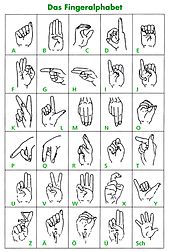Sign language
This is the sighted version that was marked on June 15, 2021. There are 5 pending changes that still need to be sighted.
A sign language is a visually perceptible form of speech, which is used especially by non-hearing and hard of hearing people for communication. Communication takes place with a combination of gestures, facial expressions, the mouth image of silently spoken words and changes in body posture. These elements are combined to form sentences and sentence sequences.
Sign languages are fully developed natural languages of the same complexity as spoken languages. In terms of language typology, they can be compared to the highly inflectional or polysynthetic languages: A sign can contain several meaning-bearing components (morphemes) at the same time.
For deaf-blind people, there is a variant of sign language in which signs (hand movements and hand shapes) are communicated through touch and perceived with the sense of touch. In addition, there are certain cultures in which non-deaf people also use or have used a sign language, such as the female members of the Australian Warlpiri tribe and the indigenous peoples of North America. Distinct from sign languages are manual coding systems (signs) used by people who have difficulty with spoken language due to another impairment, such as AAC users and people with mutism or on the autism spectrum.
It is not certain how many sign languages there are in the world. The 2013 edition of the journal Ethnologue lists 137 sign languages. However, dialects are not included in this listing - for example, 12 dialects can be distinguished in Switzerland.
.jpg)
Communication by means of sign language
The nature of sign language and its relation to spoken language
The signs are phonologically decomposed into four parameters, which are further analyzed phonemically: in hand configuration, hand orientation, movement execution and place of movement. Many signs are highly inflected. Information can be incorporated pronominal (through different visible forms) in a single gesture, e.g. in DGS the verb gesture, glossed as I-BOOK-GIVE-YOU-SHELL includes the direction of movement from "I" to "you", and quickly, and the hand configuration indicates holding an imaginary book. When modified in the movement from "you" to "me", results in YOU-BOOK-GIVING-ME-FAST. The gesture can be modified with other hand shapes to indicate what is being given, such as a thick or thin book, a bottle, a football or golf ball, a piece of paper, a stack of books, etc. Added to this is the different orientation of the hand or hands, whether the object is handed horizontally or vertically. A total of seven parts of meaning can be recognized in this single gesture: Subject, receiver (singular or plural), its locality (left, right, near or far), object, size or quantity of the object, verbal adverb, once or repeatedly. In addition, additional meanings are simultaneously added by parts of the face and head movements, e.g. "gladly" or "reluctantly" can be shown with it. Besides inflection, this is also called "incorporation" in linguistics.
Because of the decomposability of signs and structuring within the sentence, sign languages must be considered as full-fledged languages in their own right. They cannot, as is often mistakenly believed, be regarded as derived from the spoken language of their environment. The name of sign language in Germany, Deutsche Gebärdensprache (DGS), does not mean German in sign form, but sign language as used by deaf speakers in Germany.
The gestures formed by the hands form the content of a sentence. In addition, movements of the upper body and the face play a prominent role. Above all, facial expressions serve to encode grammar. Many grammatical function words, such as whether or if find expression exclusively in the face. Since the grammar is mainly expressed with facial expressions, sign language speakers also tend to look into their eyes rather than at their hands.
Sign languages differ from country to country and even within a country. In German-speaking countries, the German Sign Language (DGS) used in Germany and in Luxembourg, the Austrian Sign Language (ÖGS) and the Swiss-German Sign Language (DSGS) are used. The sign language used in Liechtenstein is closely related to DSGS and can therefore be considered a DSGS dialect. Within Switzerland, DSGS knows five different dialects (Zurich, Bernese, Basel, Lucerne and St. Gallen dialect), Switzerland in turn also knows the Langue des signes Suisse romande (LSF-SR) with five dialects and the Lingua dei segni della Svizzera italiana (LIS-SI) with two varieties.
The most common is American Sign Language (ASL), used in North America, Caribbean islands other than Cuba, parts of Central America, and some African and Asian nations.
Many signs of the different sign languages are similar to each other because of their iconic or motivated origin. Many inflections in the signs are also similar in almost all sign languages. Nevertheless, a mutual understanding is not always given. The historical relationship between sign languages is decisive for communication, so that users of sign languages of the same sign language family can communicate to some extent. Since most sign languages in continental Europe belong to the French sign language family, mutual understanding is reasonably possible there. On international occasions, International Sign, Gestuno or International Sign-Talk are used, which are considered by some to be pidgin languages.
Sign languages are - as numerous studies with imaging methods indicate - processed in the same brain regions in which spoken languages are processed. From this it is concluded that human language can no longer be defined merely as a spoken language system.

For comparison: The DGS sign for German in signwriting.

The sign for German in some sign languages symbolizes a pickelhaube and used to mean "Schutzmann" in German-speaking areas.
Manual coding systems for the German language
To be distinguished from sign language are the so-called manual-visual coding systems of the German language:
- Finger alphabet
- Sign-assisted communication (GuK)
- Signs accompanying spoken language (LBG)
- Signs that support spoken language (LUG)
- Cued Speech (German: Phonembestimmtes Manualsystem; mouth-hand system)

German finger alphabet
Questions and Answers
Q: What is sign language?
A: Sign language is a means of communication using the hands and other parts of the body.
Q: What distinguishes sign language from body language?
A: Sign language is a distinct way of communicating using hands and body parts, while body language encompasses all forms of nonverbal communication.
Q: How do deaf people communicate through sign language?
A: Deaf people use sign language to replace spoken languages, as sign languages are easier to use and understand for them.
Q: How is sign language different from spoken languages?
A: Sign languages use visual cues and are understood by the eyes, while spoken languages use sounds and are understood by the ears.
Q: Why are sign languages important?
A: Sign languages are crucial for deaf people to communicate with their peers and the hearing community.
Q: Can anyone learn and use sign language?
A: Yes, anyone can learn to use sign language as a means of communication, regardless of their hearing ability.
Q: Are there different types of sign languages?
A: Yes, there are many different types of sign languages that are specific to different regions and communities around the world.
Search within the encyclopedia